The Life of Professor Fuchun Yu
Biography of a great physicist and co-discoverer of NMR chemical shifts
|
Written and illustrated by persons who loved him and knew him well (names witheld upon request).
Published in Stan's Library, Editor S.Sýkora , Vol.III. First release March 21, 2009.
Permalink via DOI: 10.3247/SL3Nmr09.002
|
|
Fuchun Yu was born in Shanghai on 14 December 1914 to a family of impoverished ex-imperial mandarins. His grandfather had served as a country magistrate under the emperor. When Yu was three, his family relocated to Beijing where he spent his formative years in extreme hardship as his profligate father squandered away his wages and left the family perpetually destitute and starving. Among Yu and his nine siblings, only three reached adulthood, while the others all died young. Throughout his school years, Yu relied on being top of his class to get his tuition fees waived. While studying at university, he gave part of his scholarship funds along with some earnings from part-time work to his family to help them scrape by.
|

Fuchun Yu with his older and younger brothers (1930)
|
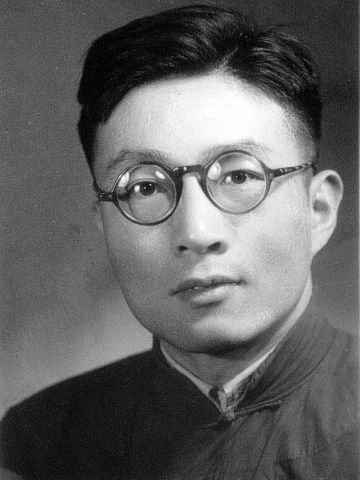
A portait taken during his stay in Kunming (1940 - 1945)
|
|
|
Yu graduated from Peking University in 1936, while China was ruled partly by the Nationalist Party, or Kuomintang, and partly by local warlords, and then worked at the Central Research Academy in Shanghai for a year. In 1937, the Japanese army invaded and sacked Beijing. During the following two years Yu experienced unemployment, hunger and the humiliation of the Japanese occupation. In 1938 the three best-known Chinese universities - Peking University, Tsinghua University and Nankai University - merged to become the Southwest United University and relocated to a campus in Kunming, in the far southwest corner of China near the Burmese border. In 1939 Yu left Beijing for Kunming and worked at the merged campus as an assistant to the dean of physics and as a lecturer until the end of the Anti-Japanese war in 1945. During this period, in 1943, he learned that virtually his entire family had died of starvation and disease in Japanese - occupied Beijing, and that only one sister had survived.
In 1945, Yu married Yueling Tian, who was a teaching assistant in the chemistry department. In 1946, Yu sailed to America via India and across the Atlantic. Between 1946 and 1949 he studied at Ohio State University where he received his PhD. In 1949 he moved to Stanford University to work with the renowned physicist Felix Bloch, and there he also met Warren Proctor. Proctor was an electronics expert while Yu, even though he was a physicist, knew a lot about structural chemistry.

Fuchun Yu in the USA (probably in 1949 at Ohio State University)
Using the world's second NMR device built by Proctor, Yu measured nuclear magnetic moments (NMM) of more than 20 stable nuclides; in an experiment originally intended to measure NMM of 15N as compared with 14N, using various ammonium and nitrate compounds, they discovered separate peaks at two slightly different magnetic resonance frequencies due to the 14N nuclides in two different ions, (NH4)+ and (NO3)-. They also offered a correct explanation for the distinct peaks and verified experimentally that their separation was proportional to the external magnetic field. The phenomenon became later known as "chemical shift", meaning that the magnetic field perceived by a nucleus - and thus its magnetic resonance frequency - depends on its chemical environment in a molecule.
Proctor and Yu very nearly missed another fundamental NMR discovery. They observed the antimonium-fluorine scalar coupling in NaSbF6 but gave an incorrect explanation for it. They can be therefore credited with the first experimental observation of the J-coupling, but not with its full comprehension.
Still at Stanford, in his collaboration with F.Alder, F.C.Yu made also another important experimental discovery. They measured the magnetic moment of the 17O nuclide and discovered that its spin was 5/2. At that time it was believed - or rather hoped - that the structure of nuclides would follow relatively simple rules similar to those of the electronic structure of atoms. For 17O, the assumed model was a proton pair and a neutron pair in "s-orbitals", each pair with mutually cancelling opposite spins, plus three proton pairs and three neutron pairs in three "p-orbitals". This would leave just one unpaired neutron in a still higher orbital, implying a total spin of 1/2. The fact that the experimental value turned out to be very different indicated that nuclear structure theory was bound to be much more complex and probably involve also substantial orbital contributions.
The work described above was done over a short one and a half years period from mid-1946 to early 1951, when Yu worked at Stanford. It was the only time in his life when he enjoyed real freedom to pursue his scientific interests. He had never enjoyed so much freedom before that, and he never had so much freedom again afterwards.
In February 1951, 15 months after the Communist Party had come to power in Peking (now renamed as Beijing), Yu took his wife Yueling and son Hezeng (also known as Bernard) back to China with the patriotic desire to help build his country under what was supposed to be a progressive new regime. From that point on he was a professor of physics until the end of his life, initially in the Department of Physics of Peking University, and then in the Department of Technical Physics as well as the Institute of Heavy Ion Physics. He served as acting dean of the Department of Physics 1951-1952, director of the Laboratory of Common Physics 1952-1955, deputy dean of the Department of Technical Physics 1955-1982, dean of the Department of Physics (1982-1983), director of the Institute of Heavy Ion Physics 1983-1986, and then director of the state committee of physics-teaching materials for the natural sciences 1984-1990.
In 1955 under his guidance, the nuclear physics and nuclear electronics laboratories were established from scratch in the department of technical physics. In the 1970s research on heavy ion linear accelerator was started. Yu initiated a new course on accelerator radio frequency electronics and personally led his students and researchers to build many instruments. In the late 1970s when China was just beginning to open up, he studied computer languages and brought the first computers into his department's laboratory research efforts. In the 1980s he organised a new group for ion beam physics and applications, and studied and lectured on the interaction physics of ion beam with solid state. After he reached 80, he continued working with his students in the labs, conducting simulations and calculations, and even at the ripe old age of 85, he learned a new computer language.
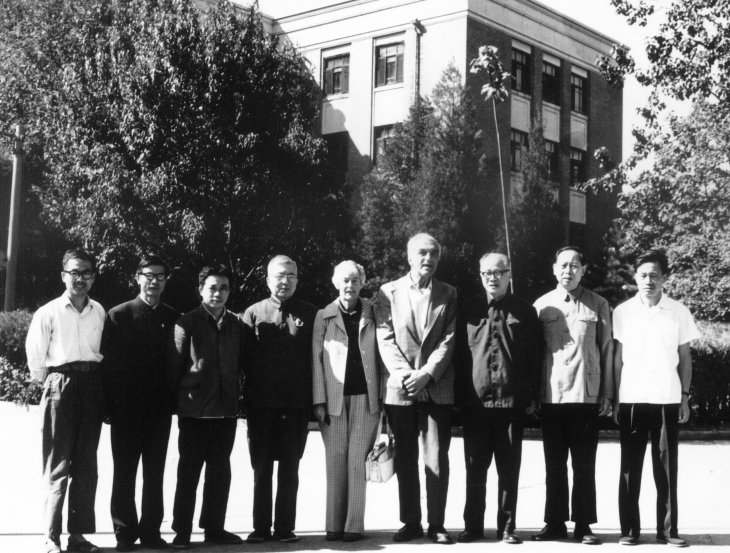
Identified persons in this September 1980 photo taken at Peking University:
Left to right, starting with 4th person: Fuchun Yu, Mrs. Bloch, Felix Bloch and Ganchang Wang
He had an abundance of experience in teaching physics involving almost all physics courses ranging across the whole spectrum of common physics, experimental physics, theoretical physics, nuclear physics, computer physics, and instrumental physics. For many years he was editor-in-chief of both state journals - Physics Experiments and Teaching Instruments & Experiments.
He had many thousands of students scattered across the world. Many of them became academicians of the Chinese Academy of Sciences. He never made fame or profit the aim of his life. He directed many of his students to write and publish articles and never put his own name on them, always giving fame to the younger generation. He was known for his rigorous self-discipline, elegance of teaching, and neat handwriting; he often reminded his students to be pioneers of innovation, and not to blindly follow in their teachers' footsteps.
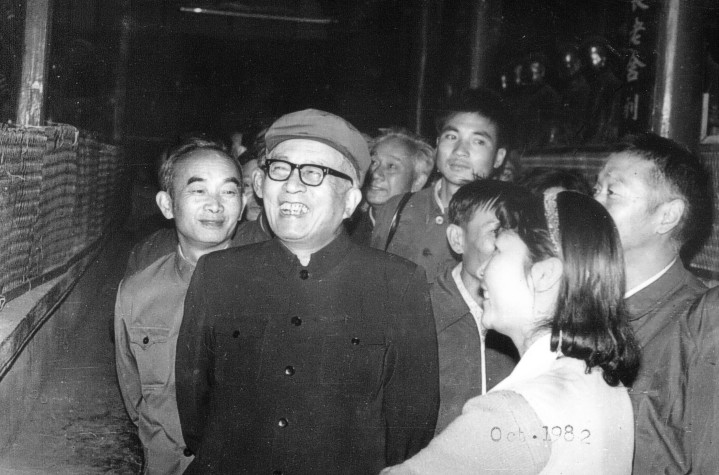
Fuchun Yu in Wuchang, Hubei Province, China
In China, Communist Party politics dominated people's career prospects including academic recognition and honours. Toeing the party line was more important than genuine academic prowess. Orthodoxy led to power, fame and material benefits. But Yu never bought into this hollow dogma. Until his dying day, he was never made an Academician of the Chinese Academy of Sciences, which had more than 1,400 members, including quite a number of his own students, but also a considerable number of party faithful with questionable "academic" credentials.
In his teaching and research he never bent with the wind of politics nor compromised his moral judgment and knowledge. In 1958 during the frenzy of Chairman Mao's so-called Great Leap Forward, Yu insisted on real science and opposed the politically driven fantasy science of that period. He was criticized for being a conservative, a "stumbling block", but he continued to coach his students to adhere to true scientific methods and not to fake results.
During the later turmoil of the Cultural Revolution (1965-1976), Yu's family, like millions in China during that period of anarchy and abuse, was split up and all four members were sent to different parts of the country to be "reformed by manual labour". Yu was sent to central China to work on the railways. His wife Yueling was labelled as a "reactionary professor" and was dispatched to work in the oilfields along the eastern seaboard. His son Bernard toiled in the fields of central China. His daughter Yingzeng (born in China in 1953) spent five years labouring on the farms in China's far northeast and then five years working in a padlock factory. During that fraught period, Yu's family lost many family possessions - photos, books, transcripts, letters, musical record collection - looted from Yu's home by Mao's fanatical followers.
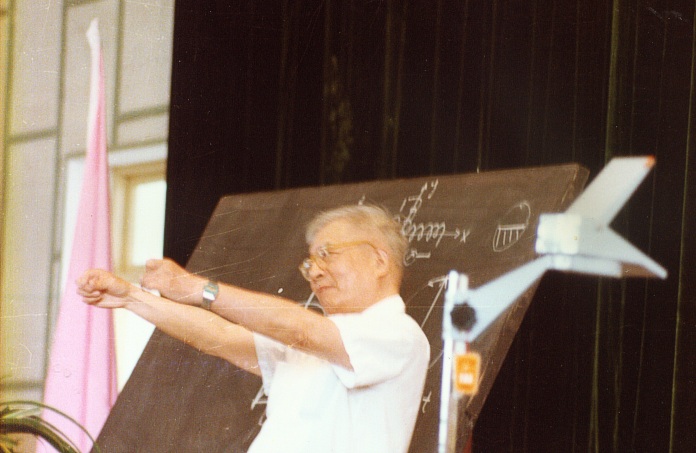
Fuchun Yu gaving a talk in Tianjin on 18 July 1986
Professor Yu suffered a heavy stroke on 7 December 2001. He was paralysed and bedridden for 14 months before he died on 12 February 2003. More than 250 people attended his funeral. His son Bernard, originally trained as an astro-physicist lives in the United States where he works as a high level software engineer. His daughter Yingzeng, who trained in finance and is the only non-scientist in Yu's family, resides in Beijing with her husband and a teenage son.
The total dedication of Prof. Yu to young people and to teaching was due in part to a profound sense of gratitude and loyalty he felt towards his mentor, Professor Rao Yutai, who lent him 300 Chinese dollars to flee Beijing during the Japanese occupation. When Yu was offered a position by Felix Bloch at Stanford, a Stanford colleague recalls him saying: "I need to return to China to help my professor". Sadly, in the 1960s, Rao committed suicide amidst the anti-intellectual persecutions of the Cultural Revolution. When Yu lay on his own deathbed in Beijing in 2003, one of his final gestures was to ask his daughter to get a sculpture made in memory of Prof. Rao. The bust of Prof. Rao now stands at the Physics Institute of Peking University.
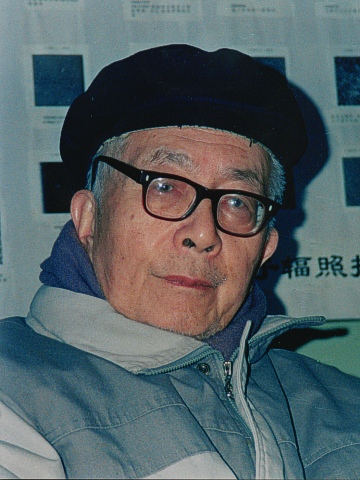
Fuchun Yu's 80th birthday portrait
|
|
|
Editor's notes:
It is a privilege to me to publish this touching account of the life of an important Chinese scientist caught in the whirlwinds of 20th century world events. Whirlwinds which are still in action, a reason why I have to invoke my right and duty to maintain the anonymity of my sources. The rights to this text and photographs, however, belong to the Authors who can be contacted through Stan's Library. Any use of the text and photos for commercial purposes is subject to a prior permission by the Authors. The slightly retouched photographs were handled in the same way as the photos published in the Log Cabin Photographic Collections on this web site and are subject to the same legal rules. Their originals remain in the possession of the Authors.
As Editor, I have left the text in the British version of English and made very few editing changes. The one and only liberty I have taken was to edit the single 'scientific' paragraph of the original text. Guided by the original papers, I have expanded it and split it into three paragraphs, describing the discovery of chemical shifts, the near discovery of scalar coupling constants, and the discovery and importance of the large spin of the 17O nuclide, respectively. The original para was phrased as follows:
Using the world's second NMR device built by Proctor, Yu measured nuclear magnetic moments (NMM) of more than 20 stable nuclides; in a conditional experiment to measure NMM of 15N as compared with 14N, using compound ammonium nitrate NH3+NH4NO3+Cr(No3)3, they discovered two different magnetic resonance frequencies for nitrogen nuclei from two different ions of NH3 (NH4) and NO3 respectively, a phenomenon which later became known as "chemical shift" - meaning that the magnetic resonance frequency strongly depends on the chemistry environment of the nucleus in a molecule. In his collaboration with F. Alder, Yu measured NMM of 17O and discovered 17O's self spin to be 5/2 instead of 1/2. This would support a model of nuclear structure involving spin-orbit coupling.
In the "western" part of the world, Fuchun Yu (often written as Fu Chun Yu, or abbreviated as F.C.Yu) will be remembered primarily for the discovery of chemical shifts, while in China his historic importance is much broader.
On this website, F.C.Yu is mentioned in the following articles and blog entries:
- Reminiscences of the Early Days of Nuclear Magnetic Resonance at Stanford University by W.Proctor (doi 10.3247/SL1Nmr05.002).
- Chemical Shifts and Shyness, a blog entry by myself.
- The story of Fu Chun Yu, co-discoverer of chemical shifts, a blog entry.
- Biography of Fu Chun Yu, a blog entry.
- The Life of Professor Fuchun Yu, URL of this article.
The following is a chronological list of references to F.C.Yu's papers published mostly in "western" Journals.
He no doubt published many more papers in Chinese Journals but I am not in a position to find them out.
- Ma S.T., Yu F.C.,
Electromagnetic Properties of Nuclei in the Meson Theory,
Phys.Rev. 62, 118-126 (1942).
DOI: 10.1103/PhysRev.62.118.
- Proctor W.G., Yu F.C.,
On the Magnetic Moments of Sn115, Cd111, Cd113, Pt195, and Hg199,
Phys.Rev. 76, 1728-1729 (1949).
DOI: 10.1103/PhysRev.76.1728.3.
- Proctor W.G., Yu F.C.,
On the Magnetic Moments of Mn55, Co59, Cl37, N15, and N14,
Phys.Rev. 77, 716 (1950).
DOI: 10.1103/PhysRev.77.716.
- Proctor W.G., Yu F.C.,
The Dependence of a Nuclear Magnetic Resonance Frequency upon Chemical Compounds,
Phys.Rev. 77, 717 (1950).
DOI: 10.1103/PhysRev.77.717.
Discovery of chemical shifts (in 14N and 15N).
Read the Proctor's account.
- Proctor W.G., Yu F.C.,
On the Magnetic Moments of Xe129, Bi209, Sc45, Sb121, and Sb123,
Phys.Rev. 78, 471 (1950).
DOI: 10.1103/PhysRev.78.471.
- Proctor W.G., Yu F.C.,
On the Nuclear Magnetic Moments of Several Stable Isotopes,
Phys.Rev. 81, 20-30 (1951).
DOI: 10.1103/PhysRev.81.20.
First observation of scalar coupling (wrong explanation).
Read the Proctor's account.
- Alder F., Yu F.C.,
On the Spin and Magnetic Moment of O17,
Phys.Rev. 81, 1067 (1951).
DOI: 10.1103/PhysRev.81.1067.
This experiment led to the first major revision of nuclear physics theories.
- Alder F., Yu F.C.,
On the Magnetic Moments of Mg25, Re185, Re187, and Be9,
Phys.Rev. 82, 105 (1951).
DOI: 10.1103/PhysRev.82.105.
- Yan J., Li Z., Bai C., Yang W.S., Wang Y., Zhao W., Kang Y., Yu F.C., Zhai P., Tang X.,
Scanning tunneling microscopy investigation of graphite surface damage induced by gold-ion bombardment,
J.Appl.Phys. 75, 1390 (1994).
DOI: 10.1063/1.356419
- Liang J.C., Xu Z., Le X.Y., Zhao W.J., Yu F.C., Liu Z., Chen R.T., Sun X.P., Zheng X.Z., Du Y.R., Zhao M.X.,
Shen L.F., Gu H.E., Li Y., Su Y.
Chemical Shifts of 23Na in NaCl Crystal Specimens Implanted with Xenon Ions,
Chinese Physics Letters 16, 563 (1999).
Link to abstract
-
The following articles are important historic references mentioning Yu:
- Proctor W.G., Proctor Warren G.: When You and I Were Young, Magnet,
in Encyclopedia of Magnetic Resonance, Vol.1 - Historical Perspectives,
John Wiley 2007. DOI: 10.1002/9780470034590.emrhp0144.
- Packard M.E., ,
Proctor Warren G.: When You and I Were Young, Magnet,
in Encyclopedia of Magnetic Resonance, Vol.1 - Historical Perspectives,
John Wiley 2007. DOI: 10.1002/9780470034590.emrhp0136.
|
|